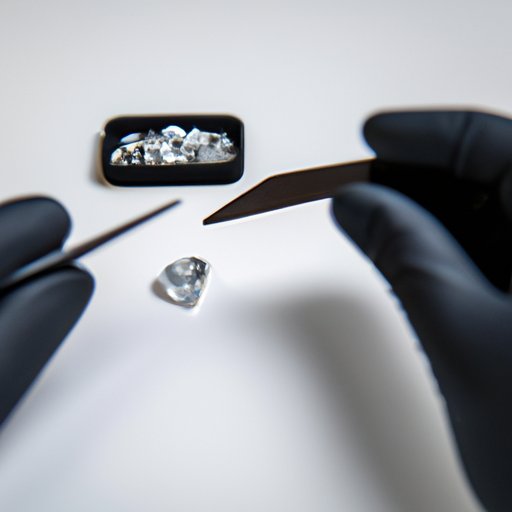Introduction
A real diamond is a precious gemstone made up of carbon atoms that have been arranged in a unique crystalline structure. It is important to be able to identify a real diamond because it can be difficult to tell the difference between a real diamond and a man-made diamond or a simulated diamond. This article will explore the various ways to tell a real diamond from a fake one.

Looking for Flaws or Inclusions
One way to tell if a diamond is real is to look for flaws or inclusions. These are small imperfections or blemishes inside the diamond that can help to identify it as being real. A loupe or magnifying glass may be needed to look for these flaws and inclusions. When inspecting the diamond, it should be looked at from multiple angles to get a better view of any potential flaws or inclusions.
Checking for Certification
Another way to tell if a diamond is real is to check for certification. Most diamonds that are purchased retail will come with a certification from a reputable gemological laboratory. The certification will provide information such as the weight, cut, color, and clarity of the diamond. This certification can also be used to verify the authenticity of the diamond.
Comparing the Diamond
When trying to determine if a diamond is real, it can be helpful to compare it to another diamond. This comparison can include things such as the size, shape, and sparkle of the diamond. Comparing the diamond to another diamond of the same type can help to identify any differences that may indicate a fake diamond.
Examining the Cut, Color, and Clarity
The cut, color, and clarity of a diamond can also be used to identify a real diamond. The cut of a diamond affects how light is reflected off of it, so examining the cut of a diamond can help to tell if it is real or not. The color of a diamond can also be inspected to make sure it is not too light or too dark. Finally, the clarity of a diamond can be examined to make sure that there are no visible blemishes or inclusions.
Testing Thermal Conductivity
Testing the thermal conductivity of a diamond is another way to identify a real diamond. This test involves placing the diamond on a thermal plate and measuring its ability to conduct heat. A real diamond will conduct heat more quickly than a fake diamond, so this test can help to differentiate between the two.
Performing a Refractive Index Test
The last step in determining if a diamond is real is to perform a refractive index test. This test involves measuring the way light reflects off of the diamond. A real diamond will reflect light differently than a fake diamond, so this test can help to confirm the authenticity of the diamond.
Conclusion
Identifying a real diamond is an important skill to have. This article has explored the various steps that can be taken to tell a real diamond from a fake one, including looking for flaws or inclusions, checking for certification, comparing the diamond, examining cut, color, and clarity, testing thermal conductivity, and performing a refractive index test. By following these steps, one can be sure that they are purchasing a real diamond.


